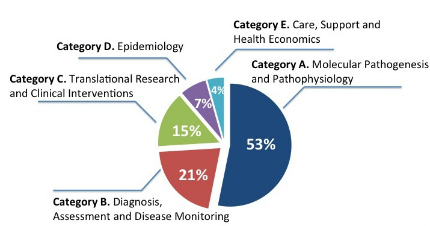A Bird’s-Eye View of Alzheimer's Research
Quick Links
As research on Alzheimer's disease becomes a growing societal priority worldwide, the National Institute on Aging and the Alzheimer's Association have launched the International Alzheimer's Disease Research Portfolio (IARDP). By organizing thousands of studies on AD into one central database, IADRP will help sponsors identify funded research to avoid duplication, coordinate funding efforts, and spot gaps in support. Researchers may find it useful for the same reasons. With the participation of nine funding agencies and four more that joined recently, the organizers aim to create a comprehensive overview of global efforts to fund Alzheimer's research.
"We want to be as strategic as possible in our funding … and determine the best way spend our research dollars," said Heather Snyder of the Alzheimer's Association. The collaborative effort took lessons from a comparable partnership established more than a decade ago for the cancer community, called the International Cancer Research Partnership, she said.
Launched in the spring of 2012, the IADRP database has steadily gained contributors. It now contains funding data from 2008–2011 for six federal and three private agencies: the National Institutes of Health; Administration on Aging; Agency for Healthcare Research and Quality; Centers for Disease Control and Prevention; U.S. Army Medical Research and Materiel Command; U.S. Department of Veterans Affairs; Alzheimer's Association; Alzheimer's Drug Discovery Foundation (ADDF); and Alzheimer's Research UK. The IADRP tracks more than 2,000 separate projects from 24 countries that together account for almost $2 billion in research funds (see image below). Data from the BrightFocus Foundation (formerly the American Health Assistance Foundation), Alzheimer’s Society UK, Alzheimer’s Australia, and Alzheimer’s Society of Canada are being coded for upload, as is the 2012 funding information for all members.

AD Research Breakdown[Image courtesy NIH]
The database classifies supported research in a three-tiered taxonomy that allows users to compare funding in progressively more detail. Alternatively, people can search for specific projects by keywords, research topics, principal investigators, funding agencies, or geographical locations (see the NIA blog post for more information about how to navigate the site). In this way, funding agencies can see who funds what, and what has already been tried. Researchers can get a better idea of what is going on in their field, identify possible collaborators, and determine which funders might take an interest in their research. In addition, the database offers interactive charts and graphs that let users compare year-to-year funding across categories for various funding agencies.
"We used that feature in our annual report, to show how we differ from other funding agencies," said Diana Shineman of ADDF. The report showed funders that ADDF duplicated no other agencies' efforts, and let them see for themselves how ADDF's portfolio contributed to the bigger picture of AD research. Before IADRP, there was no one cohesive landscape of AD funding, added Shineman. One could look at what individual agencies reported, but it was hard to compare them or see how their contribution fit with worldwide research support.
To expand IADRP, its partners are reaching out to other nonprofits, charities, and global federal agencies. Participants will be added gradually, Snyder said, as it takes a considerable time and resources to gather data and code it for entry into the system. The National Institute on Aging funds the database, although the total cost is unknown, she told Alzforum.—Gwyneth Dickey Zakaib
References
External Citations
Further Reading
Annotate
To make an annotation you must Login or Register.

Comments
No Available Comments
Make a Comment
To make a comment you must login or register.